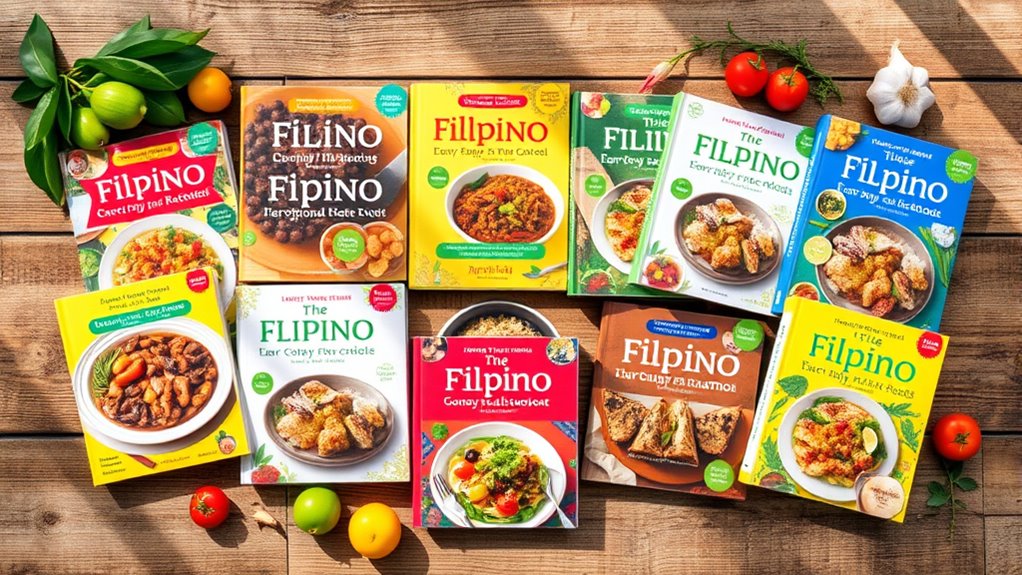If you’re just starting your journey into Filipino cooking, I recommend checking out The Easy Filipino Cookbook and A Simple Filipino Cookbook. They both offer easy-to-follow recipes and cultural stories that bring the cuisine to life. I Am a Filipino: And This Is How We Cook also connects you to your heritage with its engaging narratives. Each book has its unique charm, making your cooking experience enjoyable. Stick around, and I’ll share more about these amazing cookbooks!
Key Takeaways
- Variety of Options: Cookbooks offer diverse recipes, including heart-healthy and gluten-free choices, catering to various dietary needs and preferences.
- Easy-to-Follow Recipes: Most cookbooks feature clear instructions and ingredient lists, making them suitable for beginners and novice cooks.
- Cultural Insights: Many books include personal stories and historical context, enhancing the cooking experience and fostering a deeper connection to Filipino culture.
- Visual Appeal: Several cookbooks showcase vibrant images, helping readers visualize dishes and enhancing their overall cooking experience.
- Accessibility: Cookbooks focus on accessible ingredients that can be found at local Asian grocery stores, simplifying the cooking process for beginners.
The Easy Filipino Cookbook: 100 Classics Made Simple
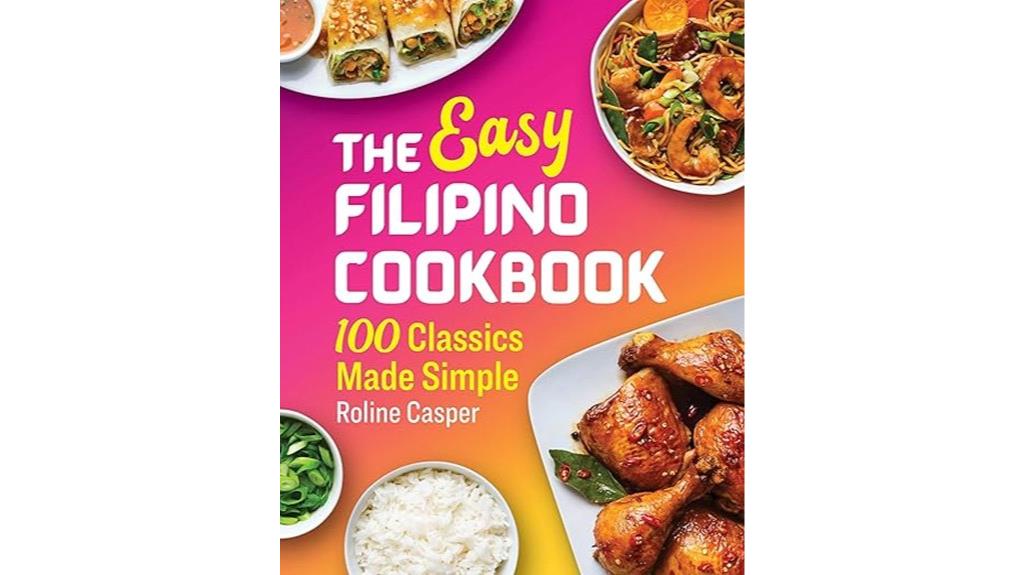
If you’re new to Filipino cooking and want to explore the cuisine without feeling overwhelmed, *The Easy Filipino Cookbook: 100 Classics Made Simple* is perfect for you. This cookbook features 100 classic recipes that are not only delicious but also easy to follow. I found the instructions clear, and many substitutes are provided, making it beginner-friendly. While I wish there were more photos to guide me, the thick pages and well-designed layout make it enjoyable to use. Overall, this book’s authenticity and ease of preparation make it a fantastic resource for anyone keen to delve into Filipino culinary heritage.
Best For: Beginners looking to explore Filipino cuisine with easy-to-follow recipes and authentic flavors.
Pros:
- Clear and well-formatted instructions make recipes easy to follow.
- Provides helpful substitutes for ingredients, catering to various dietary needs.
- Thick pages and a well-designed layout enhance usability and presentation.
Cons:
- Lack of photos for individual dishes may detract from the cooking experience.
- Limited visual references could make unfamiliar recipes harder to approach.
- Some users may feel the book resembles a colorful novel rather than a traditional cookbook.
A Simple Filipino Cookbook: Everyday Recipes and Festive Cuisine From the Philippines
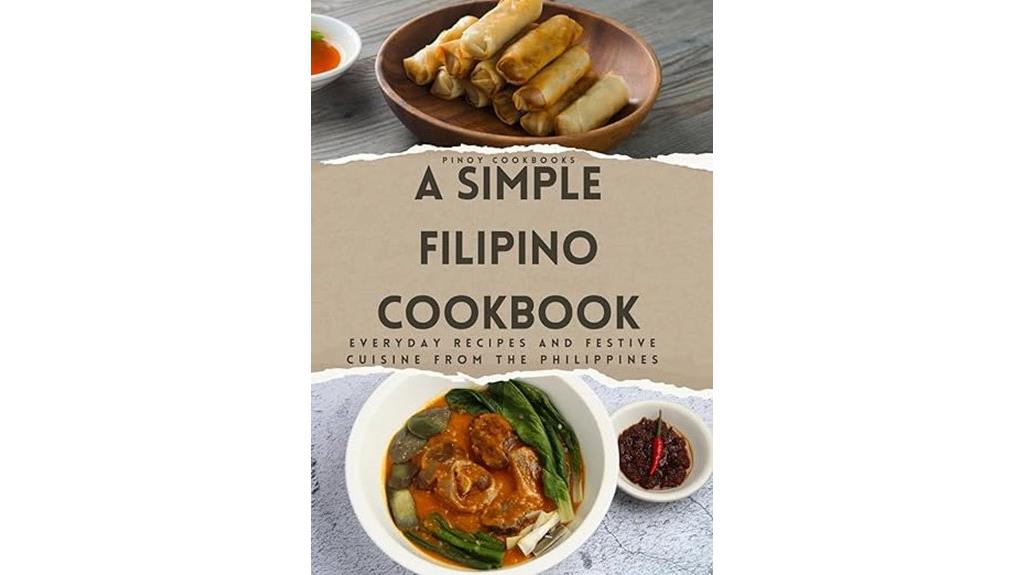
For anyone enthusiastic to plunge into the rich flavors of Filipino cuisine, “A Simple Filipino Cookbook: Everyday Recipes and Festive Cuisine From the Philippines” is an excellent choice. With over 50 authentic recipes, it’s perfect for both beginners and seasoned cooks. The clear instructions and vibrant images make cooking enjoyable and accessible. I love how it dives into Filipino culture, sharing the history behind each dish, which adds depth to the cooking experience. Plus, the ingredient guide helps you find what you need, even if you’re far from a Filipino market. It’s truly a treasure for anyone wanting to explore these delightful flavors.
Best For: Anyone interested in exploring or reconnecting with authentic Filipino flavors and culture, from novice cooks to seasoned chefs.
Pros:
- Clear and easy-to-follow recipes, making it accessible for cooks of all skill levels.
- Engaging cultural insights that enhance the cooking experience and connect readers to Filipino heritage.
- Comprehensive ingredient guide with alternatives for those lacking access to traditional components.
Cons:
- Limited vegetarian options, focusing more on meat-based dishes.
- Some readers may find certain ingredients difficult to source, even with the guide.
- The emphasis on traditional recipes may not cater to those seeking modern or fusion adaptations.
I Am a Filipino: And This Is How We Cook
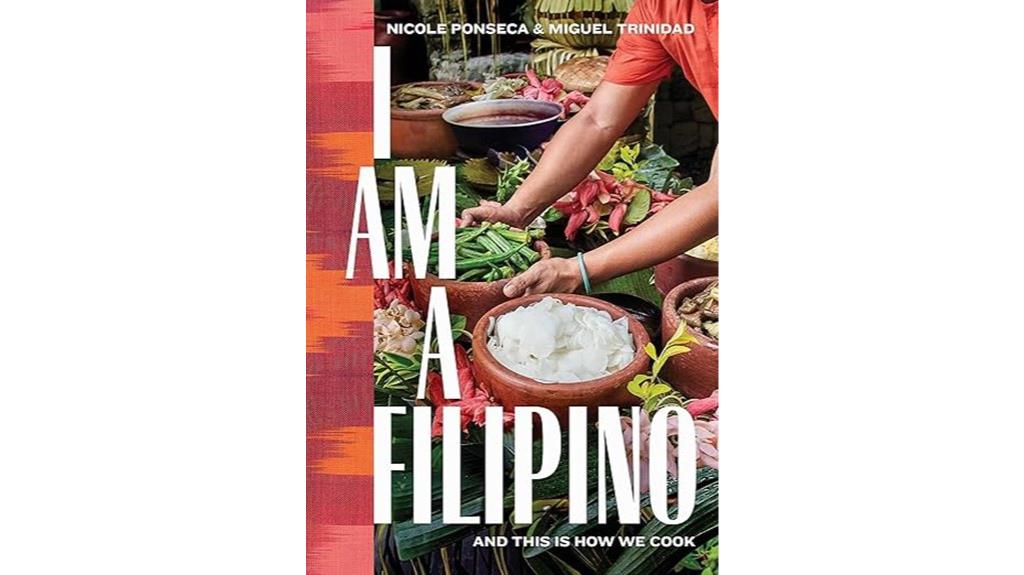
“I Am a Filipino: And This Is How We Cook” stands out as the perfect choice for anyone keen to plunge into authentic Filipino cuisine. This cookbook not only offers delicious recipes but also dives into the rich cultural tapestry of the Philippines. I appreciate the clear instructions and the accessibility of most ingredients at local Asian grocery stores. The emotional stories resonate deeply, making it more than just a cookbook; it’s a connection to my heritage. While I’d love to see more bilingual editing and regional insights, it’s a fantastic starting point for anyone eager to explore Filipino cooking.
Best For: Those looking to explore authentic Filipino cuisine and connect with their cultural heritage through cooking.
Pros:
- Clear and easy-to-follow recipes that cater to various skill levels.
- Most ingredients are accessible at local Asian grocery stores.
- Emotional stories and cultural insights enhance the cooking experience.
Cons:
- Inconsistencies in bilingual editing may hinder understanding for some readers.
- Limited regional insights could leave a desire for deeper exploration of Filipino culinary diversity.
- Some recipes may require specialty ingredients that are not widely available.
The Easy Filipino Cookbook: 100 Classics Made Simple
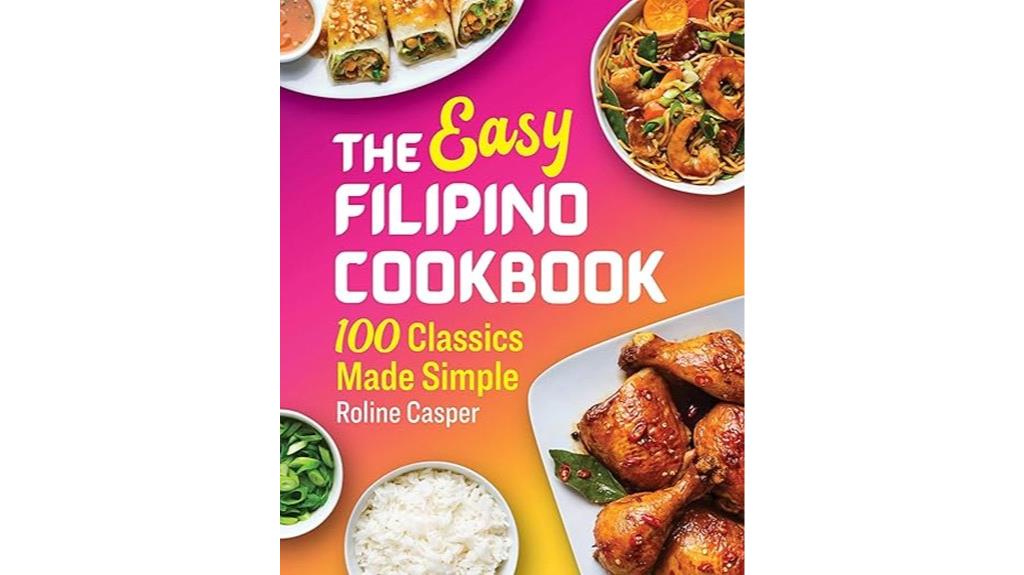
The Easy Filipino Cookbook: 100 Classics Made Simple is perfect for anyone keen to immerse themselves in Filipino cuisine without feeling overwhelmed. I found the recipes delicious and incredibly easy to follow, with clear instructions and helpful substitutes. While I wished for more pictures to accompany each dish, the vibrant presentation and thick pages make the book appealing. It’s heartwarming to see how this cookbook can foster personal connections to Filipino culture, like sharing recipes with my family. Overall, this cookbook is an excellent introduction to authentic flavors, making it a must-have for anyone keen to explore Filipino cooking.
Best For: Anyone looking to explore and enjoy Filipino cuisine with easy-to-follow recipes and authentic flavors.
Pros:
- Recipes are delicious and easy to follow, making them suitable for beginners.
- Thick pages and a readable font enhance the overall presentation of the cookbook.
- The book helps foster personal connections to Filipino culture through traditional recipes.
Cons:
- Lack of pictures for individual dishes may hinder usability for some users.
- Some reviewers feel the book reads more like a novel than a typical cookbook due to limited visual references.
- Including images of ingredients alongside instructions could improve clarity and appeal.
Quintessential Filipino Cooking: 75 Authentic Recipes

If you’re enthusiastic to plunge into Filipino cuisine, “Quintessential Filipino Cooking: 75 Authentic Recipes” is an excellent choice for beginners. This cookbook offers clear, easy-to-follow instructions and short ingredient lists, perfect for honing your cooking skills. I love the full-color photos that not only guide me but also enhance my kitchen decor. The recipes evoke nostalgia, connecting me to my roots, especially when I share them with family. Plus, the book adapts for ingredient availability, making it accessible for everyone. It truly fosters a sense of community, drawing both Filipinos and non-Filipinos together through the joy of cooking.
Best For: Beginners and those looking to reconnect with Filipino cuisine through accessible and authentic recipes.
Pros:
- Clear and concise instructions make cooking easy for all skill levels.
- Full-color photos enhance visual appeal and help with presentation.
- Recipes evoke nostalgia and foster cultural connections, especially for those living abroad.
Cons:
- Some recipes may require hard-to-find ingredients in certain regions.
- A few users may find that they need to adjust flavors to suit personal preferences.
- The book may not cater to those looking for modern or fusion interpretations of Filipino dishes.
Filipino Instant Pot Cookbook

For anyone enthusiastic to explore Filipino cuisine without feeling overwhelmed, the Filipino Instant Pot Cookbook stands out as an ideal choice. I love how this cookbook blends classic and modern recipes, making them accessible for busy cooks. Dishes like adobo and sinigang have become staples in my kitchen thanks to the clear instructions and practical notes. The Instant Pot truly cuts down on cooking time, allowing me to savor authentic flavors even on hectic days. Plus, the community engagement around this book inspires me to share my culinary adventures, deepening my connection to Filipino heritage. It’s a must-have for any aspiring chef!
Best For: The Filipino Instant Pot Cookbook is best for busy individuals and families looking to explore authentic Filipino cuisine with easy-to-follow recipes.
Pros:
- Clear instructions and practical notes make it accessible for novice cooks.
- Significantly reduces cooking time for traditional Filipino dishes.
- Fosters community engagement and sharing of culinary experiences.
Cons:
- Some ingredients may be difficult to find in certain locations.
- Users may need to make adjustments for ingredient substitutions.
- The focus on Instant Pot recipes may limit traditional cooking methods.
101 Thai Dishes You Need to Cook Before You Die
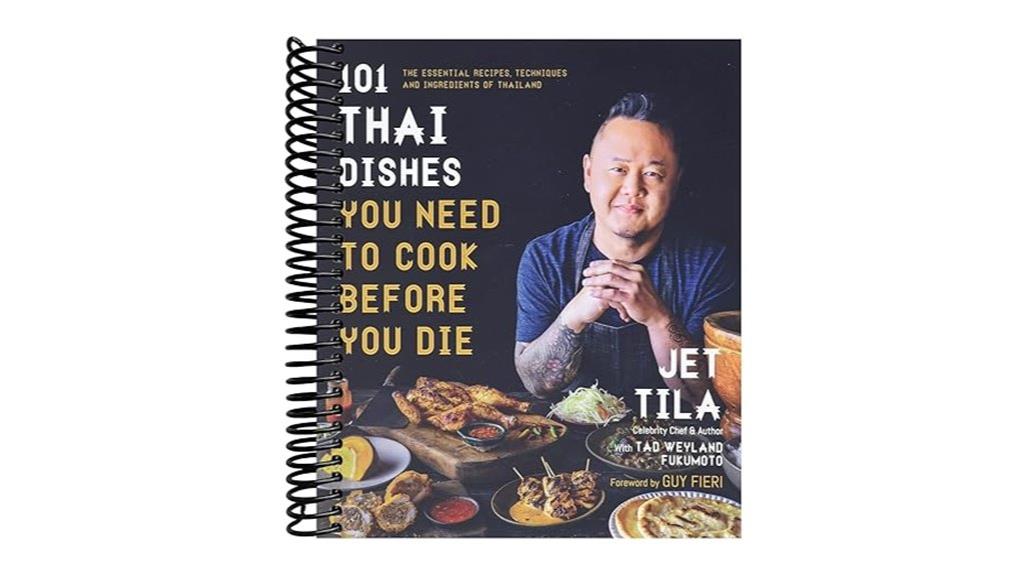
Looking to spice up your kitchen adventures? “Filipino Cookbooks for Beginners” serves as an excellent entry point for anyone enthusiastic to explore the vibrant world of Thai cuisine. One standout is “101 Thai Dishes You Need to Cook Before You Die.” It’s user-friendly, with simple directions and essential recipes. I love how it highlights quick cooking techniques, delivering authentic flavors without the fuss. Some ingredients can be tricky to find, but growing your own or shopping online helps. As I’ve tried dishes like Chicken Pad Thai, my family’s excitement motivates me to keep experimenting with new recipes!
Best For: Home cooks looking to explore authentic Thai cuisine with easy-to-follow recipes.
Pros:
- Clear and user-friendly instructions make it accessible for beginners.
- Offers a variety of recipes, including options for gluten-free diets.
- Quick cooking techniques maintain authentic flavors without extensive prep time.
Cons:
- Some ingredients may be difficult to find locally.
- More photographs of finished dishes would enhance visual engagement.
- The speed of cooking may be overwhelming for novice chefs.
Filipino Recipes Cookbook of Authentic Dishes
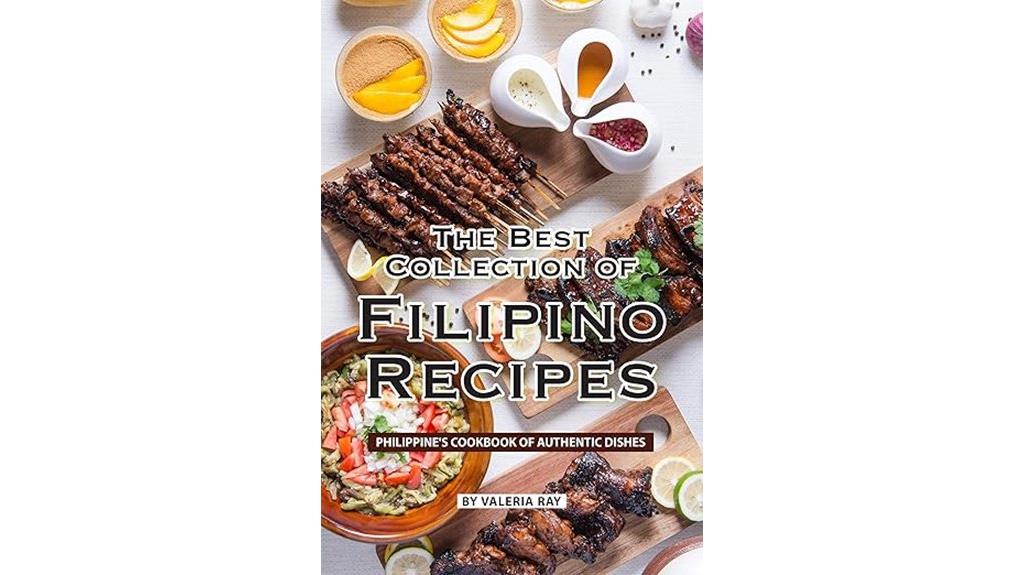
The “Filipino Recipes Cookbook of Authentic Dishes” stands out as the perfect choice for anyone wanting to immerse themselves in the flavors of Filipino cuisine without feeling overwhelmed. It evokes nostalgia, reminding me of childhood meals that were simply delicious. While the recipe variety is somewhat limited, with only one seafood dish, I appreciate how easy the instructions are to follow. Most ingredients are accessible, although some might be tricky to find. I’ve received positive feedback after gifting this book, as it beautifully captures classic and authentic Filipino flavors that resonate deeply with many of us.
Best For: Those looking to explore authentic Filipino cuisine with easy-to-follow recipes that evoke nostalgic flavors.
Pros:
- Recipes evoke childhood memories and are described as delicious and tasty.
- Clear and easy-to-understand instructions make cooking accessible for all skill levels.
- Positive reception from users highlights the classic and authentic nature of the dishes.
Cons:
- Limited variety of recipes, with only one seafood dish included.
- Some ingredients may be hard to locate, impacting cooking inspiration.
- Overall number of recipes available is somewhat restricted.
We Cook Filipino: Heart-Healthy Recipes and Inspiring Stories from Filipino Food Personalities
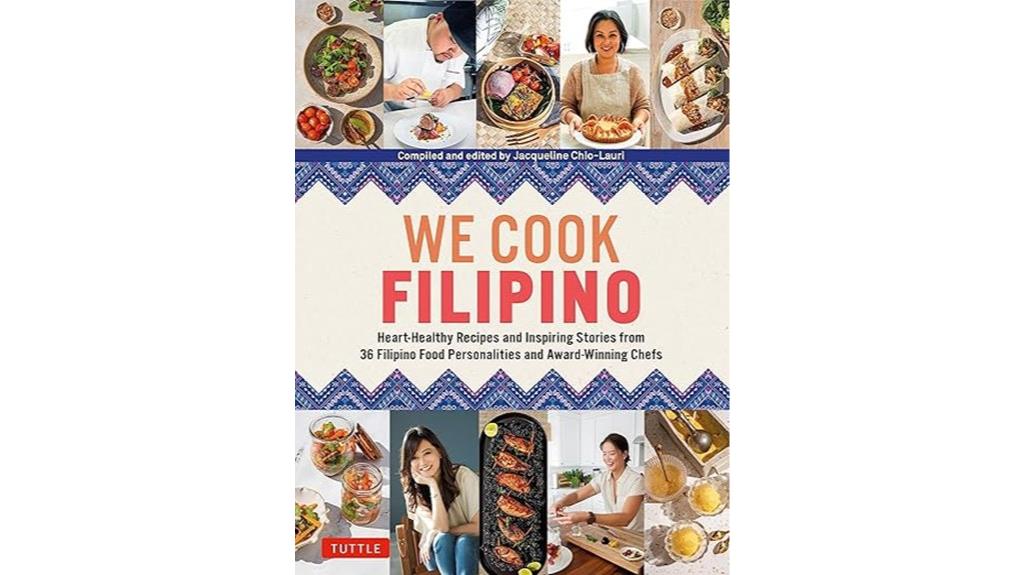
If you’re enthusiastic to explore Filipino cuisine while prioritizing health, “We Cook Filipino: Heart-Healthy Recipes and Inspiring Stories from Filipino Food Personalities” is a fantastic choice. This collaborative cookbook features heart-healthy recipes from 36 acclaimed chefs, blending tradition with nutrition. You’ll find accessible ingredients and a variety of dishes for every meal—think Daing na Bangus and Meatless Tortang Giniling. The personal stories behind each recipe deepen your connection to Filipino culture, making cooking an engaging experience. With its charming layout and stunning photography, this book not only serves as a practical guide but also as a beautiful keepsake.
Best For: Health-conscious individuals looking to explore authentic Filipino cuisine while enjoying heart-healthy recipes.
Pros:
- Variety of Recipes: Offers a diverse selection of dishes for all meals, catering to different tastes and dietary preferences.
- Cultural Insights: Includes personal stories from chefs that enhance the cooking experience and connect readers to Filipino heritage.
- Attractive Design: Features a charming layout and appealing photography, making it a delightful gift and a beautiful addition to any kitchen.
Cons:
- Ingredient Availability: Some recipes may require specific ingredients that aren’t readily available in all regions.
- Health Focus: While the recipes are heart-healthy, those seeking traditional, indulgent Filipino dishes may find some adaptations less satisfying.
- Collaboration Variability: The quality and style of recipes may vary given the contributions from multiple chefs, which could affect consistency.
Filipino Homestyle Dishes Cookbook (Over 60 Recipes)
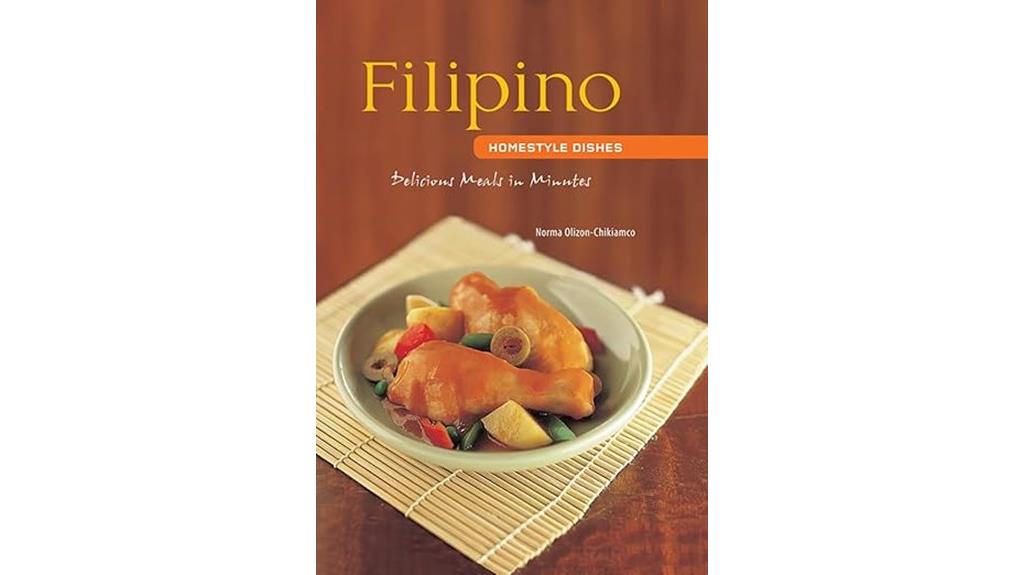
With over 60 easy-to-follow recipes, “Filipino Homestyle Dishes” is perfect for anyone keen to explore the rich flavors of Filipino cuisine, whether you’re a beginner or simply new to these dishes. The spiral-bound format makes it convenient to use, laying flat while you cook. Each recipe comes with a picture, helping you visualize the final dish, and the historical context adds depth to your cooking experience. While some ingredients may be tricky to find, the authenticity of these recipes shines through. I’ve found this cookbook to be an excellent starting point for anyone excited to immerse themselves in Filipino cooking.
Best For: Those looking to explore authentic Filipino cuisine through easy-to-follow recipes, especially beginners and food enthusiasts.
Pros:
- Recipes are simple and beginner-friendly, making them accessible for all cooking skill levels.
- Each recipe is accompanied by a picture, enhancing understanding and presentation of the final dish.
- The spiral-bound format allows the cookbook to lay flat, making it convenient while cooking.
Cons:
- Some ingredients may be difficult to find, necessitating substitutions.
- A few recipes might require adjustments for enhanced flavor, as they serve as a basic starting point.
- While it offers over 60 recipes, some may prefer a cookbook with a larger variety of options.
The Ultimate Filipino Cookbook: 111 Dishes From Philippines
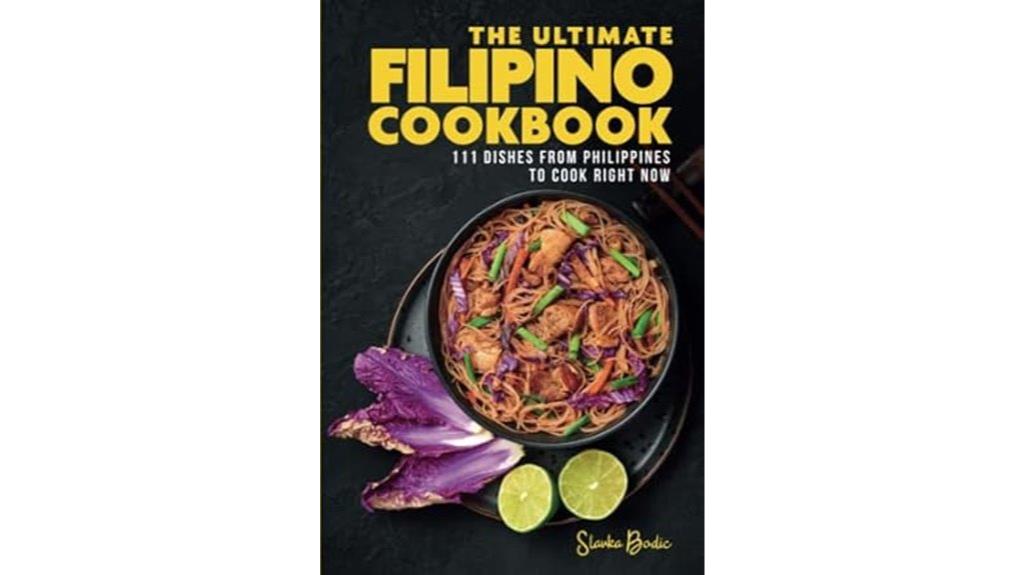
For those enthusiastic to explore Filipino cuisine, “The Ultimate Filipino Cookbook: 111 Dishes From Philippines” offers an intriguing collection of recipes. However, I found some recipes frustrating due to unclear instructions and missing ingredients. The lack of nutritional information is also a downside. Visually, the book disappoints with only three black-and-white images that don’t match the recipes. Critics question the authenticity since the author isn’t Filipino, using unconventional ingredients in classic dishes. While some readers appreciate discovering traditional flavors, many, including myself, feel this cookbook needs better editing and clearer directions to truly shine.
Best For: Those looking to explore Filipino cuisine while being aware that clarity and authenticity may vary.
Pros:
- Offers a variety of traditional Filipino dishes for those unfamiliar with the cuisine.
- Some recipes provide a unique twist that could appeal to adventurous cooks.
- Can serve as a starting point for individuals interested in learning about Filipino cooking.
Cons:
- Instructions are often unclear, leading to confusion during preparation.
- Lacks nutritional information, which may be important to health-conscious readers.
- Questions about authenticity due to the author’s background and use of unconventional ingredients.
Amboy: Recipes from the Filipino-American Dream
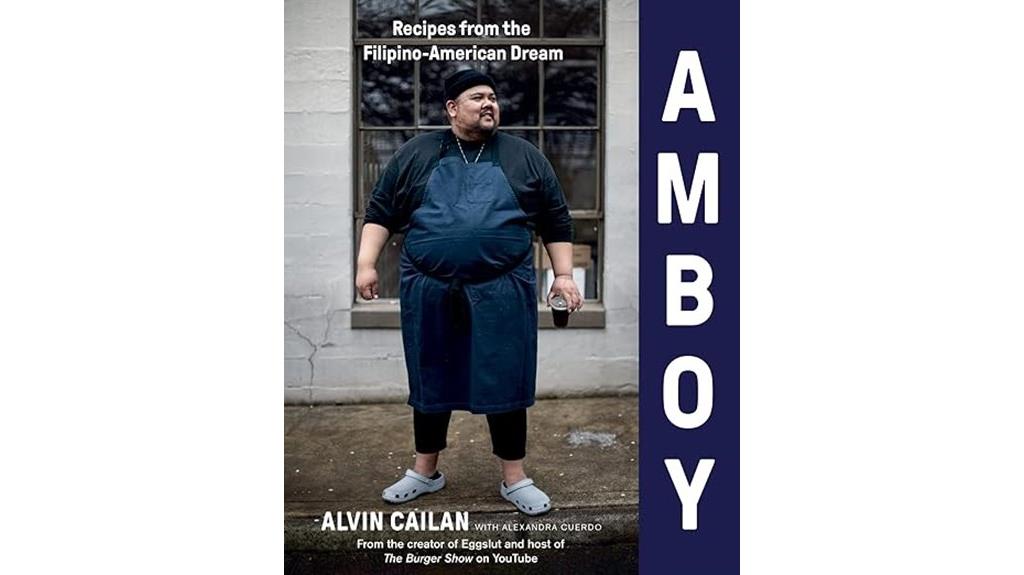
“Amboy: Recipes from the Filipino-American Dream” stands out as an essential resource for anyone enthusiastic to explore Filipino cuisine, especially those new to cooking. The engaging narrative draws you in like a thriller, making it hard to put down. I loved learning how to cook perfect Jasmine rice and tried my hand at Pan de Sal, which was a delightful challenge! Each recipe, from Hot Si-log to Mechado, comes with helpful tips that helped me improve my skills. This cookbook beautifully captures the Filipino-American experience, making it a wonderful gift that fosters community and nostalgia for our heritage.
Best For: This cookbook is best for individuals eager to explore and embrace Filipino cuisine, especially those new to cooking or seeking to connect with their cultural roots.
Pros:
- Engaging narrative makes the cooking experience feel thrilling and enjoyable.
- Unique recipes highlight traditional Filipino dishes, including rare finds like Pan de Sal.
- Practical cooking tips help improve skills and adapt recipes to personal preferences.
Cons:
- Quality control issues have been reported, with some books arriving damaged.
- Navigation warnings in the Kindle version may deter some users, despite overall functionality.
- Minor adjustments may be needed for some recipes, which could be challenging for beginner cooks.
Filipino Recipe Cookbook
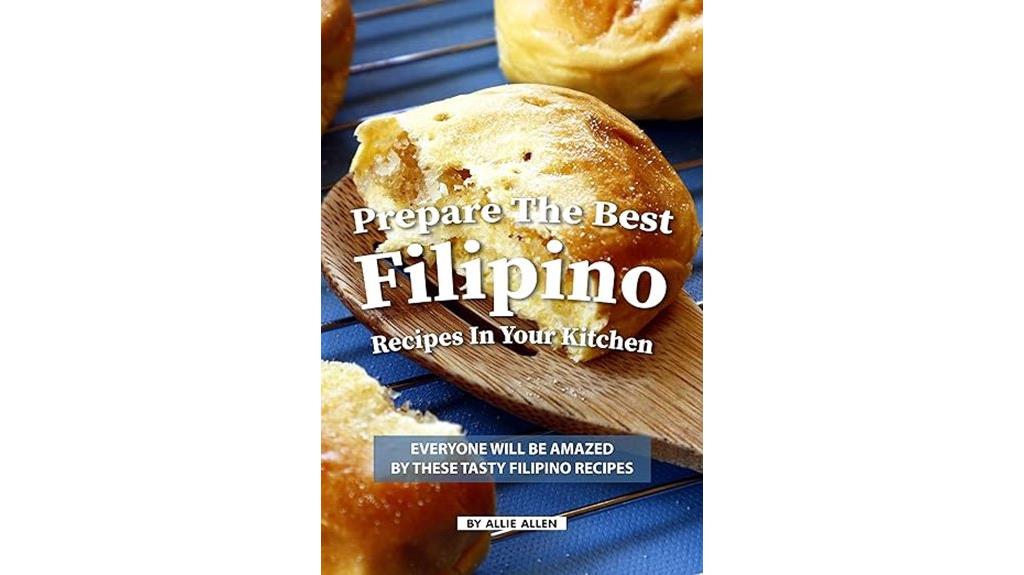
If you’re just starting your culinary journey, the “Filipino Recipe Cookbook” is perfect for you. It offers clear and practical recipes that include all necessary ingredients and accurate measurements, ensuring your cooking experience is smooth. Each recipe is tested, so you won’t encounter any discrepancies that could lead to confusion. I love how the book emphasizes both authenticity and ease, making it ideal for beginners. Plus, it presents dishes in an organized manner, highlighting their cultural significance and visual appeal. Gathering feedback helps improve recipes, so you can trust that you’re making dishes that resonate with others.
Best For: Beginners looking to explore Filipino cuisine with clear, easy-to-follow recipes.
Pros:
- Authenticity: Recipes maintain traditional flavors while being approachable for novice cooks.
- Thorough Testing: Each recipe is tested for accurate measurements and practical execution.
- Cultural Insight: Dishes are presented with cultural significance, enhancing appreciation and understanding.
Cons:
- Limited Advanced Recipes: More experienced cooks may find the selection lacking in complex dishes.
- Potential for Over-Simplification: Some recipes may be too simplified for those seeking authentic, intricate cooking techniques.
- Feedback Variability: User experience can vary, and some may still encounter issues despite thorough testing.
Factors to Consider When Choosing Filipino Cookbooks for Beginners
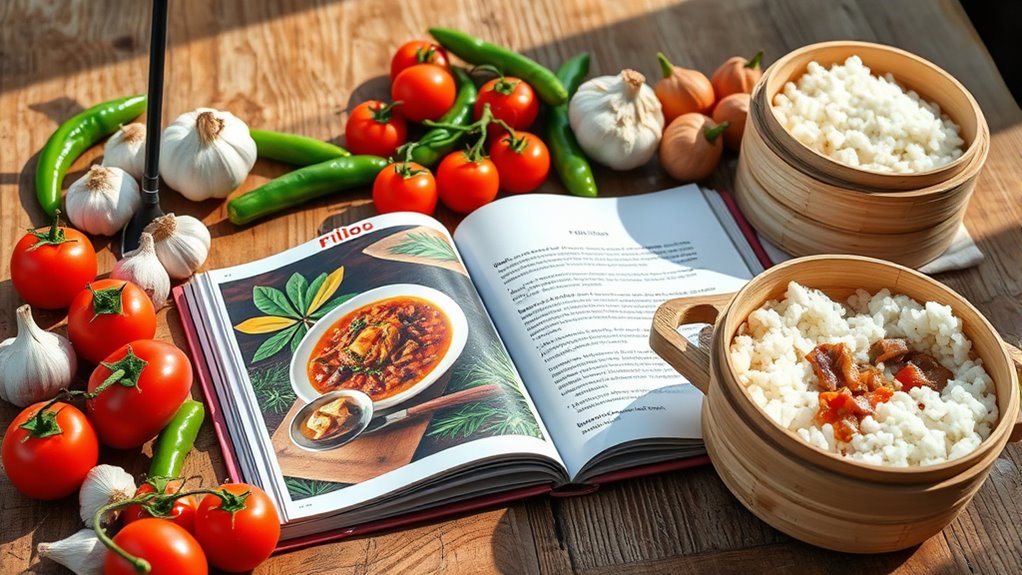
When I’m picking a Filipino cookbook as a beginner, I focus on a few key factors. Recipe clarity and how visually appealing the book is can make a big difference in my cooking experience. I also look for insights into the culture and whether the ingredients are easy to find or have good alternatives.
Recipe Clarity and Simplicity
Choosing a Filipino cookbook as a beginner can feel overwhelming, but focusing on recipe clarity and simplicity makes the process much easier. I always look for cookbooks with well-formatted instructions; clear, step-by-step directions are essential for success. Recipes with shorter ingredient lists are more accessible, especially for those of us who aren’t culinary experts. It’s also helpful when cookbooks provide substitutes for hard-to-find ingredients, ensuring I don’t get discouraged. I appreciate cookbooks that share various techniques and tips for adapting traditional recipes, empowering me to experiment and build confidence. Finally, I love when these books include personal anecdotes and stories, making the cooking experience more relatable and enriching. This connection truly enhances my journey in learning Filipino cuisine.
Visual Appeal and Photos
Cooking from a cookbook becomes even more enjoyable with the right visual elements. I’ve noticed that many beginner-friendly Filipino cookbooks lack sufficient images, which can make it tough to grasp unfamiliar recipes. A clear presentation featuring full-color photographs of finished dishes is essential for visual learners like me. It not only enhances the cookbook’s appeal but also inspires confidence to try new dishes. I appreciate cookbooks that include images of the cooking process or ingredients alongside the instructions, as they provide extra clarity and guidance. Without these visuals, I often feel disconnected from the recipes, making it harder to envision the final outcome. So, when choosing a cookbook, prioritize those with vibrant visuals to enhance your cooking experience.
Cultural Insights and Context
While diving into Filipino cuisine, I find that cookbooks rich in cultural insights truly elevate the cooking experience. These books often share the history and significance behind traditional dishes, allowing me to appreciate the depth of Filipino heritage. I love how many cookbooks include personal stories from Filipino chefs, creating a connection between the recipes and the vibrant experiences of communities. Understanding staple foods and traditional cooking methods enhances my culinary journey, fostering a deeper bond with Filipino practices. Additionally, it’s invigorating to see cookbooks highlight the communal aspect of dining, emphasizing how food unites people—a core value in Filipino culture. This context not only makes cooking more enjoyable but also meaningful.
Ingredient Accessibility and Alternatives
Ingredient accessibility is essential when exploring Filipino cookbooks, especially for beginners like me who might not have easy access to specialty markets. I’ve found that many cookbooks include helpful ingredient guides, which really simplify the process of identifying traditional components. This is great for someone just starting out. Some cookbooks even suggest alternatives for hard-to-find ingredients, making it easier to recreate authentic flavors without too much hassle. I appreciate how common ingredients like soy sauce, garlic, and pepper are emphasized, as they pop up frequently in recipes. Clear instructions on ingredient substitutions enhance my cooking experience, allowing me to adapt recipes based on what I have at home. This focus on accessibility truly makes a cookbook more user-friendly.
Cooking Techniques and Adaptability
When diving into Filipino cookbooks, I find that understanding cooking techniques and adaptability can greatly enhance my culinary journey. Effective cookbooks should offer clear, concise instructions, making it easy for beginners like me to follow along. It’s essential to choose books that suggest alternative ingredients, especially when some aren’t readily available. This adaptability helps me recreate authentic flavors without stress. I also appreciate cookbooks that include practical tips and techniques; they boost my confidence and skill in the kitchen. A well-structured layout with step-by-step guidance and visuals aids my comprehension. Finally, I love cookbooks that explore various cooking methods—like stovetop, oven, and Instant Pot—to cater to my skill level and available equipment, promoting versatility in my cooking.
Frequently Asked Questions
What Kitchen Tools Are Essential for Filipino Cooking?
When I think about essential kitchen tools for Filipino cooking, a few items come to mind. First, I can’t live without a heavy-duty mortar and pestle for making pastes and sauces. A large wok is perfect for stir-frying, and a rice cooker is a must-have for perfectly cooked rice. Don’t forget about the bamboo steamer for dishes like siomai. Finally, a good knife set makes prepping ingredients a breeze. Happy cooking!
Are There Vegetarian Options in Filipino Cuisine?
Filipino cuisine offers plenty of vegetarian options. I love dishes like Pinakbet, a flavorful vegetable stew, and Ginataang Sitaw, which features string beans in coconut milk. There’s also Adobong Kangkong, a simple yet delicious water spinach dish. When I cook, I often substitute meat with tofu or mushrooms to create a hearty meal. So, if you’re exploring Filipino food, don’t worry—there are delicious vegetarian choices waiting for you!
How Can I Adjust Recipes for Dietary Restrictions?
Adjusting recipes for dietary restrictions can feel like fine-tuning a musical instrument; it takes practice to get it just right. I usually start by identifying the main ingredients and consider suitable substitutes. For instance, if a recipe calls for meat, I might use tofu or legumes instead. I also play with spices to keep flavors vibrant. Don’t hesitate to experiment; cooking’s all about finding what works for your taste and health needs!
What Are Common Filipino Cooking Techniques?
When I think about Filipino cooking techniques, a few stand out. I often use sautéing, or “ginisa,” to build flavors with garlic, onions, and tomatoes. Steaming, or “pangat,” is another favorite, especially for dishes like fish. I love braising, or “nilaga,” which tenderizes meat in broth. Finally, grilling, or “inis” adds a smoky depth to dishes. These techniques create the vibrant, rich flavors that make Filipino cuisine so unique and delicious!
Where Can I Find Authentic Filipino Ingredients?
Ah, the quest for authentic Filipino ingredients—it’s like searching for unicorns in a grocery store! Don’t fret; I’ve got your back. I usually hit up local Asian markets where I find the freshest produce and specialty items. Online shops like Amazon or specialty grocery websites also offer a treasure trove of goodies. If you’re lucky, a nearby Filipino community might have pop-up markets. Trust me; the effort’s worth it for that true flavor!
Conclusion
In diving into the world of Filipino cuisine, these cookbooks are your guiding stars. They’ll lead you through vibrant flavors and rich traditions, making the cooking journey as delightful as the dishes themselves. Whether you’re whipping up a cozy family meal or impressing friends with a festive feast, these resources offer something for everyone. So grab a book, roll up your sleeves, and let the aromas of the Philippines fill your kitchen!
